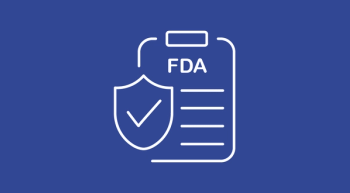
Open-Label Ponsegromab Appears Effective in Cancer-Associated Cachexia
Ponsegromab increased body weight in patients with cancer-associated cachexia, yielding greater improvement in those who received ponsegromab previously.
Ponsegromab treatment over 64 weeks resulted in sustained improvements in body weight and suppression of growth differentiation factor 15 (GDF-15), a stress-induced cytokine, irrespective of prior treatment assignment, with a consistent tolerable safety profile, according to information shared in a presentation at the 2025 ESMO Congress.
Patients initially randomized to placebo benefited from weight gain upon transitioning to ponsegromab, although absolute gains were lower than those continuously treated, presenter Jeffrey Crawford, MD, emphasized, during the presentation.
Crawford, a medical oncologist at Duke Cancer Center and Duke Cancer Center Thoracic Clinic, in Durham, North Carolina, presented the 1-year open-label extension results from the randomized phase 2 study evaluating ponsegromab in patients with cancer-associated cachexia, building on previously reported 12-week double-blind data (NCT05546476).
“Improvements in body weight at week 12 … continued with ponsegromab through week 64 in the open-label extension,” explained Crawford to the audience in Berlin, Germany. “Patients assigned to placebo in Part A showed an improvement in body weight during the open label extension, but overall, their body weight gain was less than what we observed for patients who received ponsegromab throughout the study.”
What Is Cancer-Associated Cachexia and GDF-15’s Role?
Cachexia remains a common complication in oncology, with no currently approved pharmacologic therapies in the US or Europe. GDF-15 has been implicated in cachexia pathogenesis through its interaction with the GFRAL receptor in the hindbrain. Crawford explained that ponsegromab is a potent, highly selective humanized monoclonal antibody that binds GDF-15, preventing its signaling through GFRAL.
In the preceding 12-week double-blind study, ponsegromab demonstrated improvements in body weight, appetite, cachexia-related symptoms, overall physical activity, and skeletal muscle mass vs placebo, with a favorable safety profile. The current analysis aimed to evaluate longitudinal changes in body weight, GDF-15 levels, and safety over a 64-week treatment period.
Randomized Phase 2 Ponsegromab Study Design: Part A and Part B
The trial comprised 2 parts. Part A was a 12-week double-blind, randomized, placebo-controlled study. Eligible patients included those with non-small cell lung cancer (NSCLC), pancreatic cancer, or colorectal cancer (CRC), meeting Fearon criteria for cachexia, with elevated circulating GDF-15 (> 1500 pg/mL), ECOG performance status of 3 or less, and life expectancy 4 months or more.
Patients were randomized to placebo or ponsegromab at 100 mg, 200 mg, or 400 mg subcutaneously every 4 weeks for 3 doses. The primary endpoint of Part A was change in body weight at week 12, with secondary endpoints including patient-reported outcomes, physical activity, gait, safety, and lumbar skeletal muscle index.
Part B consisted of a 52-week open-label extension in which all eligible patients received ponsegromab 400 mg subcutaneously every 4 weeks through week 64. Exploratory end points included changes from baseline in body weight, pharmacokinetics, circulating GDF-15 concentrations, immunogenicity, and safety and tolerability.
Statistical analyses included descriptive summaries and mixed model repeated measures incorporating covariates such as baseline, time, baseline-by-time interaction, treatment assignment, treatment-by-time interaction, type of therapy (platinum vs non-platinum), and cancer type.
Patient Enrollment and Baseline Characteristics of the Ponsegromab Trial
A total of 281 patients were screened, with 187 randomized to Part A. Screening failures included not meeting inclusion criteria (n = 77), patient withdrawal (n = 12), death (n = 4), and other reasons (n = 1).
Completion rates at week 12 were 68.0% to 84.8% across treatment arms, and 117 patients entered Part B, with 37 completing the full 52-week extension. Primary reasons for discontinuation included progressive disease (n = 25), death (n = 17), adverse effects (n = 9), withdrawal (n = 11), and global health status deterioration (n = 8).
Baseline demographics were balanced across treatment arms in Part B (total n = 117), with median age 68 years (IQR, 61-74), 35.9% female, median BMI 20.1 kg/m² (IQR, 17.8-22.4), and 70.9% of patients with stage 4 disease.
Cachexia severity at baseline included 38.5% of patients with 5% to 10% weight loss and 43.6% with 10% or more weight loss in the preceding 6 months. NSCLC represented 44.4% of patients, CRC 29.1%, and pancreatic cancer 26.5%. ECOG performance status was predominantly 0 or 1 (84.6%), and median serum GDF-15 levels were 3581 pg/mL (IQR, 2259–7125).
Sustained Weight Gain Observed Across 64-Week Study of Ponsegromab
Observed mean changes from baseline in body weight for Part B patients demonstrated progressive gains over the 52-week open-label extension. At week 12, reflecting Part A treatment assignment, the overall mean increase was 1.26 kg (SD, 3.68), rising to 5.18 kg (SD, 5.92) at week 64, corresponding to a mean 9.35% increase from baseline.
When stratified by Part A assignment, patients initially randomized to placebo experienced weight loss at week 12 but gained weight following initiation of open-label ponsegromab 400 mg, albeit achieving less overall gain than patients continuously treated with ponsegromab from Part A. Mixed-model analyses corroborated these outcomes, demonstrating consistent weight increases across all Part B participants.
“We note that the placebo group, across all those time points, tends to gain less weight than the group initially assigned ponsegromab,” said Crawford. “…We see an increase across all groups in weight with open-label ponsegromab 400 mg, but the initial placebo group lags behind.”
GDF-15 suppression was robust and sustained. At week 12, placebo patients demonstrated rising GDF-15 levels, whereas ponsegromab-treated groups (100 mg-400 mg) exhibited 55.1% to 97.6% reductions. After transitioning to open-label ponsegromab 400 mg, all patients achieved a median decrease in GDF-15 approximate to 97%, maintained through week 64, regardless of initial treatment.
Safety Profile: Ponsegromab Well-Tolerated With Minimal Treatment-Related AEs
Treatment-emergent adverse effects (TEAEs) were common (84.2%), largely driven by underlying malignancy, concomitant therapies, and comorbidities, according to Crawford. Grade 1-2 TEAEs occurred in 34.2%, grade 3-4 in 29.8%, and grade 5 in 20.2% of patients.
Serious TEAEs affected 43.9%, with 24.6% of patients permanently discontinuing study interventions. Importantly, treatment-related TEAEs were rare (4.4%) and limited to grade 1 and 2; no deaths were considered related to ponsegromab.
Next Steps: Phase 2b Study in Metastatic Pancreatic Cancer
These results support ongoing evaluation in the phase 2b study of ponsegromab in patients with metastatic pancreatic cancer receiving first-line chemotherapy, designed to define optimal dosing for a subsequent pivotal phase 3 trial, incorporating both cachexia-specific and treatment-related outcomes.
Reference
Crawford J, Groarke JD, Collins SM, et al. Efficacy and safety of ponsegromab in patients with cancer-associated cachexia: Results from the open-label extension of a randomized, placebo-controlled. Presented at: ESMO 2025 Congress; October 17-21, 2025; Berlin, Germany. LBA102.
Newsletter
Knowledge is power. Don’t miss the most recent breakthroughs in cancer care.

















































































